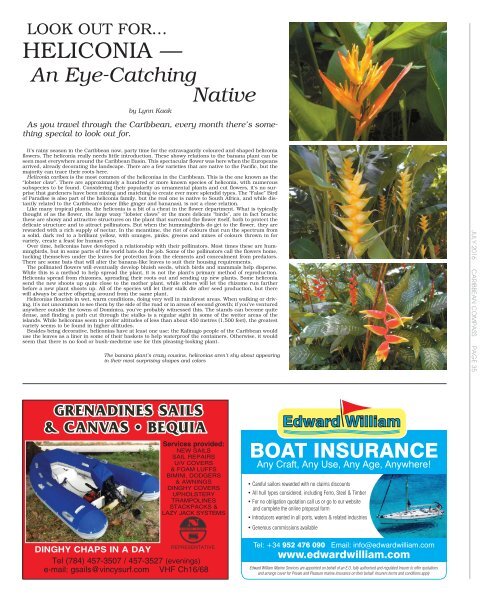Caribbean Compass Yachting Magazine July 2016
Welcome to Caribbean Compass, the most widely-read boating publication in the Caribbean! THE MOST NEWS YOU CAN USE - feature articles on cruising destinations, regattas, environment, events...
Welcome to Caribbean Compass, the most widely-read boating publication in the Caribbean! THE MOST NEWS YOU CAN USE - feature articles on cruising destinations, regattas, environment, events...
You also want an ePaper? Increase the reach of your titles
YUMPU automatically turns print PDFs into web optimized ePapers that Google loves.
LOOK OUT FOR…<br />
HELICONIA —<br />
An Eye-Catching<br />
Native<br />
by Lynn Kaak<br />
As you travel through the <strong>Caribbean</strong>, every month there’s something<br />
special to look out for.<br />
It’s rainy season in the <strong>Caribbean</strong> now, party time for the extravagantly coloured and shaped heliconia<br />
flowers. The heliconia really needs little introduction. These showy relations to the banana plant can be<br />
seen most everywhere around the <strong>Caribbean</strong> Basin. This spectacular flower was here when the Europeans<br />
arrived, already decorating the landscape. There are a few varieties that are native to the Pacific, but the<br />
majority can trace their roots here.<br />
Heliconia caribea is the most common of the heliconias in the <strong>Caribbean</strong>. This is the one known as the<br />
“lobster claw”. There are approximately a hundred or more known species of heliconia, with numerous<br />
subspecies to be found. Considering their popularity as ornamental plants and cut flowers, it’s no surprise<br />
that gardeners have been mixing and matching to create ever more splendid types. The “False” Bird<br />
of Paradise is also part of the heliconia family, but the real one is native to South Africa, and while distantly<br />
related to the <strong>Caribbean</strong>’s poser (like ginger and bananas), is not a close relation.<br />
Like many tropical plants, the heliconia is a bit of a cheat in the flower department. What is typically<br />
thought of as the flower, the large waxy “lobster claws” or the more delicate “birds”, are in fact bracts;<br />
these are showy and attractive structures on the plant that surround the flower itself, both to protect the<br />
delicate structure and to attract pollinators. But when the hummingbirds do get to the flower, they are<br />
rewarded with a rich supply of nectar. In the meantime, the riot of colours that run the spectrum from<br />
a solid, dark red to a brilliant yellow, with oranges, pinks, greens and mixes of colours thrown in for<br />
variety, create a feast for human eyes.<br />
Over time, heliconias have developed a relationship with their pollinators. Most times these are hummingbirds,<br />
but in some parts of the world bats do the job. Some of the pollinators call the flowers home,<br />
tucking themselves under the leaves for protection from the elements and concealment from predators.<br />
There are some bats that will alter the banana-like leaves to suit their housing requirements.<br />
The pollinated flowers will eventually develop bluish seeds, which birds and mammals help disperse.<br />
While this is a method to help spread the plant, it is not the plant’s primary method of reproduction.<br />
Heliconia spread from rhizomes, spreading their roots out and sending up new plants. Some heliconia<br />
send the new shoots up quite close to the mother plant, while others will let the rhizome run farther<br />
before a new plant shoots up. All of the species will let their stalk die after seed production, but there<br />
will always be active offspring around from the same plant.<br />
Heliconias flourish in wet, warm conditions, doing very well in rainforest areas. When walking or driving,<br />
it’s not uncommon to see them by the side of the road or in areas of second growth; if you’ve ventured<br />
anywhere outside the towns of Dominica, you’ve probably witnessed this. The stands can become quite<br />
dense, and finding a path cut through the stalks is a regular sight in some of the wetter areas of the<br />
islands. While heliconias seem to prefer altitudes of less than about 450 metres (1,500 feet), the greatest<br />
variety seems to be found in higher altitudes.<br />
Besides being decorative, heliconias have at least one use; the Kalinago people of the <strong>Caribbean</strong> would<br />
use the leaves as a liner in some of their baskets to help waterproof the containers. Otherwise, it would<br />
seem that there is no food or bush-medicine use for this pleasing-looking plant.<br />
The banana plant’s crazy cousins, heliconias aren’t shy about appearing<br />
in their most surprising shapes and colors<br />
JULY <strong>2016</strong> CARIBBEAN COMPASS PAGE 35<br />
GRENADINES<br />
SAILS<br />
& CANVAS • BEQUIA<br />
Services provided:<br />
NEW SAILS<br />
SAIL REPAIRS<br />
U/V COVERS<br />
& FOAM LUFFS<br />
BIMINI, DODGERS<br />
& AWNINGS<br />
DINGHY COVERS<br />
UPHOLSTERY<br />
TRAMPOLINES<br />
STACKPACKS &<br />
LAZY JACK SYSTEMS<br />
REPRESENTATIVE<br />
DINGHY CHAPS IN A DAY<br />
Tel (784) 457-3507 / 457-3527 (evenings)<br />
e-mail: gsails@vincysurf.com VHF Ch16/68<br />
BOAT INSURANCE<br />
Any Craft, Any Use, Any Age, Anywhere!<br />
• Careful sailors rewarded with no claims discounts<br />
• All hull types considered, including Ferro, Steel & Timber<br />
• For no obligation quotation call us or go to our website<br />
and complete the online proposal form<br />
• Introducers wanted in all ports, waters & related industries<br />
• Generous commissions available<br />
Tel: +34 952 476 090 Email: info@edwardwilliam.com<br />
www.edwardwilliam.com<br />
Edward William Marine Services are appointed on behalf of an E.U. fully authorised and regulated Insurer to offer quotations<br />
and arrange cover for Private and Pleasure marine insurance on their behalf. Insurers terms and conditions apply


















